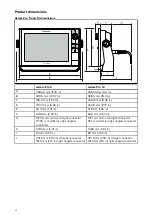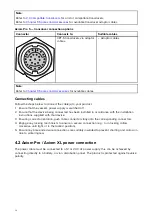
4.3 NMEA 2000 (SeaTalkng ®) connection
The MFD can transmit and receive data from devices connected on a compliant CAN bus network.
The MFD is connected to the backbone using the MFD’s NMEA 2000 connector.
1.
Use the supplied DeviceNet to SeaTalkng ® adaptor cable to connect your MFD to a SeaTalkng ®
backbone.
2. Alternatively your can connect your MFD to a NMEA 2000 backbone using a standard DeviceNet
cable (not supplied).
Note:
1.
SeaTalkng ® and NMEA 2000 devices must be connected to a correctly terminated backbone
that the MFD is also connected to. Devices cannot be connected directly to the MFD.
2. Refer to the instructions supplied with your SeaTalkng ® / NMEA 2000 device for details on
creating a backbone.
3.
Refer to
for a list of available SeaTalkng ® cables..
4.4 NMEA 0183 connection
NMEA 0183 devices can be connected to your MFD using the NMEA 0183 wires on the supplied
Power and data cable.
2 NMEA 0183 ports are available:
•
Port 1
: Input and output 4,800 or 38,400 baud rate.
•
Port 2
: Input only 4,800 or 38,400 baud rate.
Note:
• The Baud rate for each port must be set in your MFD’s settings, refer to the operation instructions
for your MFD for details on specifying baud rate.
• For Port 1, both the input and output communicate at the same baud rate. For example, if you
have one NMEA 0183 device connected to Port 1 INPUT, and another NMEA 0183 device
connected to Port 1 OUTPUT, both NMEA devices must use the same baud rate.
Up to 4 devices can be connected to the output port and up to 2 devices to the input ports.
40
















































